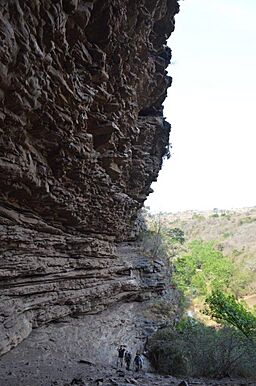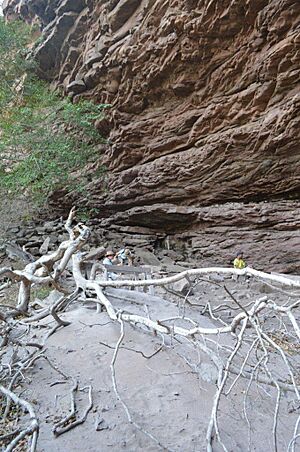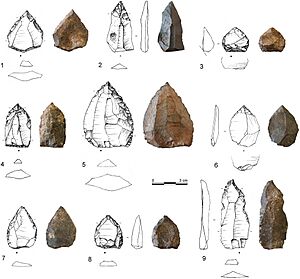Sibudu Cave facts for kids
Quick facts for kids Sibudu Cave |
|||||||||||||
|---|---|---|---|---|---|---|---|---|---|---|---|---|---|
 |
|||||||||||||
| Location | Tongaat, KwaZulu-Natal | ||||||||||||
|
|||||||||||||
Sibudu Cave is a special rock shelter found in a sandstone cliff in northern KwaZulu-Natal, South Africa. It's a very important place because it shows us how early humans lived during the Middle Stone Age. People lived here, on and off, from about 77,000 years ago to 38,000 years ago.
Scientists have found some of the oldest examples of modern human tools and inventions at Sibudu Cave. Imagine finding:
- The oldest bone arrow, about 61,000 years old!
- The oldest stone arrows, from 64,000 years ago.
- The earliest sewing needle, also 61,000 years old.
- The first known use of a special strong glue, made with heat, from 61,000 years ago.
- Evidence of people using comfy bedding, dating back 77,000 years. This was once the oldest known bedding, until an even older example (200,000 years old) was found at Border Cave in South Africa.
The discovery of these complex glues and bedding is super exciting! It helps scientists understand that early humans were very smart. Their thinking skills were much like ours today.
In 2024, Sibudu Cave became part of a special group of places called a World Heritage Site. This site is named "The Emergence of Modern Human Behaviour: The Pleistocene Occupation Sites of South Africa."
Contents
What is Sibudu Cave?
Sibudu Cave is a large rock shelter. It's located about 40 kilometres north of Durban and 15 kilometres inland. It sits near the town of Tongaat, in a steep, forest-covered cliff. The shelter looks out over the Tongati River, which helped create the cave by slowly wearing away the rock.
The floor of the shelter is about 55 metres long and 18 metres wide. It holds many layers of Middle Stone Age remains. These remains are very well preserved and scientists can accurately tell how old they are.
The cave was first found in 1983. Later, in 1998, Lyn Wadley from the University of the Witwatersrand began new excavations.
Who Lived Here?
People lived at Sibudu Cave during different times in the Middle Stone Age. Scientists divide these times into several periods:
- Early periods (before 72,000 years ago)
- The Still Bay period (72,000 to 71,000 years ago)
- The Howiesons Poort period (before 61,000 years ago)
- Later periods (from 58,500 to 38,600 years ago)
There were times when no one lived in the cave. These gaps lasted about 10,000 years. Scientists think these were dry times, and people only lived in the shelter when the weather was wet.
After the Middle Stone Age, no one lived there for a long time. But around 1000 BC, people from the Iron Age did live in the cave.
Amazing Ancient Technology
The people of Sibudu Cave were very clever! They made and used many different tools and inventions.
Here are some of the cool things they created:
- Arrows and Bows: They found a bone point that might be an arrowhead. This suggests that people were using bows and arrows as far back as 61,000 years ago! This is 20,000 years earlier than we thought before.
- Sewing Needles: The earliest known bone sewing needle was found here. It's 61,000 years old and looks like it was used to poke through animal hides.
- Super Glue: People at Sibudu made a strong glue from plant gum and red ochre. They used this glue to attach sharp stone points to wooden handles, making spears. This glue is at least 71,000 years old!
- Shell Beads: They also made beads from shells, though these are a bit newer (71,000 years old) than those found at Blombos cave (75,000 years old).
- Comfy Bedding: About 77,000 years ago, people used bedding made from sedge and other plants. They topped it with aromatic leaves from the Cape laurel tree (Cryptocarya woodii). These leaves probably kept insects away, like a natural bug spray!
- Early Paint: They used milk (casein) mixed with ochre as a paint binder about 49,000 years ago.
- Ancient Food: Scientists found dried fruits, and both burnt and unburnt seeds and nuts. These show what people ate during the Middle Stone Age, from over 60,000 years ago to about 37,000 years ago.
The plant bedding was smart! The Cape laurel leaves, when crushed, smell nice and contain chemicals that stop insects and their larvae. Even today, Cryptocarya plants are used in traditional medicine.
During the Howiesons Poort period, people made special blade tools. These blades were shaped like a segment of an orange, with a sharp cutting edge. They were attached to handles using ochre and plant glue, or fat mixed with plant material.
After the Howiesons Poort period, people used sharp points for hunting weapons, like spear tips. Many of these points were attached with glues that contained ochre.
Smart Thinking of Early Humans
Scientists have tried to recreate how these ancient tools were made. They found that making the stone spears with glue was very complex. The glue was a mix of plant gum, red ochre, and maybe a little beeswax or fat. This mix had to have the right amounts of each ingredient. Then, it needed to be heated carefully. If it got too hot, the glue would become weak.
To do all this, the early humans at Sibudu needed to think in advanced ways, just like modern people. They had to understand how different materials would react and how to combine them. This shows that their brains were capable of complex planning and abstract thought.
Some of these hafted points might even have been shot from bows. While it's hard to tell the difference between a thrown spear and an arrow from the tools alone, the types of animals hunted at Sibudu suggest bows were used. They hunted many different animals, including fast-moving ones that lived in forests. This might mean they used traps, like snares. If they used snares, it means they understood cords and knots, which are also needed to make bows. Using snares also shows they understood how energy is stored in bent branches, which is the main idea behind a bow.
The use of insect-repelling leaves in bedding also suggests that early humans understood how plants could help them. This shows a new level of smart behaviour for people at that time.
Changes in Technology Over Time
Interestingly, some amazing inventions found at Sibudu and other sites didn't always stick around. For example, shell beads appear in some layers but then disappear in later ones. This challenges the idea that technology always gets better and better over time.
Instead, it seems that new ideas and tools appeared, disappeared, and then sometimes came back. Scientists think this might have been due to changes in the environment or how people interacted in their social groups, rather than just changes in their thinking ability.
Sibudu Cave: A World Heritage Site
In 2015, the South African government suggested that Sibudu Cave should become a World Heritage Site. It was put on a list of possible future sites, along with other important places like Blombos Cave, Pinnacle Point, Klasies River Caves, Border Cave, and Diepkloof Rock Shelter. In 2024, Sibudu Cave and two other sites officially became World Heritage Sites!
See also
- Howieson's Poort Shelter
- Klasies River Caves
- List of caves in South Africa
- Modern behaviour
- Timeline of evolution
- Timeline of historic inventions
- Lyn Wadley




